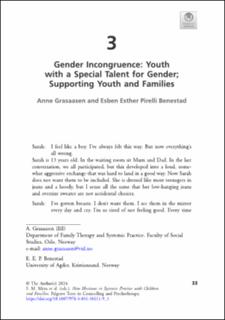| dc.contributor.author | Grasaasen, Anne | |
| dc.contributor.author | Benestad, Esben Esther Pirelli | |
| dc.date.accessioned | 2023-10-30T12:50:51Z | |
| dc.date.available | 2023-10-30T12:50:51Z | |
| dc.date.created | 2023-10-16T23:13:10Z | |
| dc.date.issued | 2023 | |
| dc.identifier.citation | Grasaasen, A., Benestad, E.E.P. (2024). Gender Incongruence: Youth with a Special Talent for Gender; Supporting Youth and Families. In: Myra, S.M., Grøver, T., Axberg, U. (eds) New Horizons in Systemic Practice with Children and Families. Palgrave Texts in Counselling and Psychotherapy. Palgrave Macmillan, Cham. | en_US |
| dc.identifier.isbn | 978-3-031-38111-9 | |
| dc.identifier.uri | https://hdl.handle.net/11250/3099439 | |
| dc.description | Open Access This chapter is licensed under the terms of the Creative
Commons Attribution 4.0 International License (http://creativecommons.org/
licenses/by/4.0/), which permits use, sharing, adaptation, distribution and
reproduction in any medium or format, as long as you give appropriate
credit to the original author(s) and the source, provide a link to the Creative
Commons license and indicate if changes were made.
The images or other third party material in this chapter are included in the
chapter’s Creative Commons license, unless indicated otherwise in a credit line
to the material. If material is not included in the chapter’s Creative Commons
license and your intended use is not permitted by statutory regulation or
exceeds the permitted use, you will need to obtain permission directly from
the copyright holder | en_US |
| dc.description.abstract | Understandings of gender are undergoing great change. In caring for children and youth experiencing gender incongruence, we reflect over how to create a systemic conversational space in which they, along with their families, can explore feelings and experiences of gender identity. The family as a phenomenon is a strong discourse, and parents’ voices are important in how this process is experienced. Their active participation in therapy can contribute to children and youth becoming secure in owning their gender identities. We describe using a gender map as an aid to talk about feelings, experiences and desires in conversations with older children, youth, parents and their networks. | en_US |
| dc.language.iso | eng | en_US |
| dc.publisher | Palgrave Macmillan | en_US |
| dc.relation.ispartof | New Horizons in Systemic Practice with Children and Families | |
| dc.rights | Navngivelse 4.0 Internasjonal | * |
| dc.rights.uri | http://creativecommons.org/licenses/by/4.0/deed.no | * |
| dc.subject | gender incongruity | en_US |
| dc.subject | gender identity | en_US |
| dc.subject | youth | en_US |
| dc.subject | families | en_US |
| dc.subject | parenthood | en_US |
| dc.title | Gender incongruence: Youth with a special talent for gender; supporting youth and families. Chapter 3 | en_US |
| dc.type | Chapter | en_US |
| dc.description.version | publishedVersion | en_US |
| dc.rights.holder | © The Author(s) 2024 | en_US |
| dc.source.pagenumber | 33-51 | en_US |
| dc.identifier.doi | https://doi.org/10.1007/978-3-031-38111-9_3 | |
| dc.identifier.cristin | 2185329 | |
| cristin.ispublished | true | |
| cristin.fulltext | original | |
| cristin.qualitycode | 2 | |

